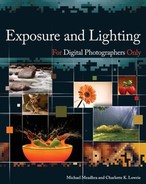When I talked to some of my photographer friends about this book, they were surprised by the "For Digital Photographers Only" part of the title. They usually made some comment to the effect that, although digital imaging has revolutionized many things about photography, exposure and lighting are still pretty much the same whether you shoot digital or film.
That's an understandable response from a bunch of former film photographers who gradually migrated to digital photography. They learned to do everything manually with film, and they've adapted that knowledge and experience to the new digital photography tools.
However, the title makes more sense for the new generation of photographers who may have never used a camera without auto-focus and auto-exposure capabilities. All those automatic features are great, but sometimes even the best automation fails, and the photographer must override the camera's automatic settings to get the shot. And sometimes you just want to exercise more creative control. The problem is that the automation that makes normal shooting so much easier can actually make manual overrides harder. Today's highly automated digital cameras tend to hide and disguise fundamentals that were obvious on old manual cameras.
For example, unless you're old enough to have gray hair and bifocal glasses (like me), you've probably never used a camera just a few mechanically timed shutter speeds, each of which doubled the previous speed. Modern cameras with electronically controlled shutters have many more shutter speeds that provide more precise exposure control. However, all those extra shutter speeds also make it harder to visualize which ones are a full stop (one EV) apart and which ones are intermediate steps.
In the past, photographers had to learn certain fundamentals in order to use a camera effectively to take pictures. But that's no longer the case. Today's cameras are capable of handling many details automatically, leaving the photographer free to concentrate on the subject and the composition. As a result, photographers can get to a moderately advanced level without mastering some of the basics — either because they never had to learn the basics to take a picture, or more likely, because the knowledge of the basics got rusty from lack of use.
This book is for digital photographers who have been relying heavily on the automatic features of their digital cameras, but are now ready to begin exercising more creative control over their images by selecting or overriding the camera's automatic exposure controls. But it's not just about exposure controls. It's also about the lighting on the subject you're photographing — whether it's finding good natural lighting or creating photographic lighting from scratch in the studio. And it's all from the perspective of a photographer who now shoots digital images instead of film.
I've tried to make this book as camera-brand agnostic as possible. The information on these pages is applicable to any digital camera with manual controls. That includes all the digital SLRs from Nikon, Canon, Olympus, Fuji, and other manufacturers, as well as many of the higher-end consumer zoom cameras. Many of the lighting tips will work with any camera — even point-and-shoot digital cameras and those antique film cameras.
